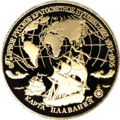First Russian circumnavigation
| The First Russian circumanvigation | |
|---|---|
|
A coin commemorating the first Russian world circumnavigation. | |
| Type | Circumnavigational expedition |
| Target | Kronstadt Island, Saint Petersburg |
| Date | August 1803 – August 1806 |
| Executed by | Adam Johann von Krusenstern, Yuri Lisyansky |
The first Russian circumnavigation of the Earth took place from August 1803 to August 1806. It was sponsored by Count Nikolay Rumyantsev, funded by the Russian-American Company, and was headed by Adam Johann von Krusenstern.[1] In addition to its exploratory goals, the expedition was also meant to help establish diplomatic and economic relations between Russia and Japan, for which the party included a large diplomatic delegation headed by Court Chamberlain and Ambassador Nikolai Rezanov.
Events



After publishing a paper pointing out the advantages of direct communication between Russia and China by Cape Horn or the Cape of Good Hope, Krusenstern was appointed by Tsar Alexander I to make a voyage to the east coast of Asia to endeavour to carry out the project.[1] Under the patronage of the Tsar, Krusenstern and Rezanov co-led the first Russian circumnavigation of the world. The purpose of the two-ship expedition was to establish trade with China and Japan, introduce Rezanov as first Russian ambassador to Japan, facilitate trade in South America, and examine California for a possible colony.
Two ships, Nadezhda ("Hope", formerly Leander) under the command of Krusenstern, and Neva (formerly Thames) under the command of Captain-Lieutenant Yuri F. Lisianski took part in the voyage. Starting from Kronstadt, both ships took a route across the Baltic Sea and the Atlantic Ocean, past the Canary Islands and Brazil, after which the ships rounded Cape Horn and set across the Pacific Ocean towards Japan, making stops at the Marquesas and the Sandwich (Hawaiian) Islands, and also at Kamchatka. However, after leaving Hawaii the ships split, and Lisianski headed to Russian America (Alaska).
The visit to Japan was a diplomatic failure, even if as a gesture of good will the Russians brought with them valuable gifts and several Japanese castaways rescued years before in the Russian North Pacific territories (these sailors thus became the first Japanese to circumnavigate the world). Nikolai Rezanov had to cancel his embassy as Japan reaffirmed once more the isolationist sakoku ("closed country") policy.
After visiting Japan, Nadezhda set off towards Sitka, Alaska, sailed past China and Macao on the Indian Ocean, then rounded Africa and came back across the Baltic Sea to Kronstadt. The voyage lasted a total of more than three years, from 7 August 1803 to 19 August 19 1806.
In 1804 Neva visited Easter Island,[2] and later that year, was essential in defeating the Tlingit in the Battle of Sitka, Alaska. In 1805 Lisianski met Krusenstern again in Macau, but they soon separated. Also in 1805, he was the first to describe the Hawaiian monk seal on the island which now bears his name.[3] Neva returned to Kronstadt on 22 July 1806, almost a month before Nadezhda.[1] Lisyanski received multiple rewards for his circumnavigate, including the Order of Saint Vladimir of 3rd degree. Both seafarers made maps and detailed recordings of their voyages.
Upon his return, Krusenstern wrote a detailed report, Reise um die Welt in den Jahren 1803, 1804, 1805 und 1806 auf Befehl Seiner Kaiserliche Majestät Alexanders des Ersten auf den Schiffen Nadeschda und Newa (Journey around the World in the Years 1803, 1804, 1805, and 1806 at the Command of his Imperial Majesty Alexander I in the Ships Nadezhda and Neva) published in Saint Petersburg in 1810. It was published in 1811-1812 in Berlin; this was followed by an English translation, published in London in 1813, and subsequently by French, Dutch, Danish, Swedish, and Italian.
Notable crew
- Adam Johann von Krusenstern, leader of the expedition and Captain of Nadezhda. Later Russian Admiral.
- Yuri Lisyansky, Captain of Neva. Won the Battle of Sitka against Tlingit during the journey.
- Nikolai Rezanov, appointed ambassador to Japan, co-led the expedition with Krusenstern until Kamchatka. One of the founders of Russian-American Company in 1799, was made an inspector of Russian colonies in America after the embassy failed; protagonist of the rock opera Juno and Avos.
- Fabian Gottlieb von Bellingshausen, lieutenant and cartographer. Published a collection of maps of Pacific following the journey. Later discovered the continent of Antarctica and a number of Pacific islands during his own circumnavigation and became Russian Admiral.
- Otto von Kotzebue, cabin boy. Later captained two circumnavigations, discovered over 400 Pacific islands and the Kotzebue Sound on Alaska.
- Fyodor Ivanovich Tolstoy, count, mischief-making participant. Acquired a fame of celebrity adventurer and nickname the American, became a propotype for Zaretsky in Pushkin's Eugene Onegin.
- Grigory Langsdorff, naturalist and physician. Later became the most renowned of Russian explorers of Brazil and South America.
- Wilhelm Gottlieb Tilesius von Tilenau, ship's doctor, marine biologist and expedition artist. His illustrated report on the expedition appeared in 1814. Also known for the reconstruction of the Adams mammoth skeleton.
Commemoration
- A series of commemorative coins from the Bank of Russia (1993)
 A map of the journey
A map of the journey

 Neva and Yuri Lisyansky
Neva and Yuri Lisyansky
See also
- Mulovsky expedition
- Circumnavigation
- List of circumnavigations
- List of Russian explorers
- 1966 Soviet submarine global circumnavigation
References
- 1 2 3
 Chisholm, Hugh, ed. (1911). "Krusenstern, Adam Ivan". Encyclopædia Britannica (11th ed.). Cambridge University Press.
Chisholm, Hugh, ed. (1911). "Krusenstern, Adam Ivan". Encyclopædia Britannica (11th ed.). Cambridge University Press. - ↑ Katherine Routledge refers to page 58 of his book - Voyage round the world in the Ship Neva Lisiansky, London 1814.
- ↑ Monachus Guardian







